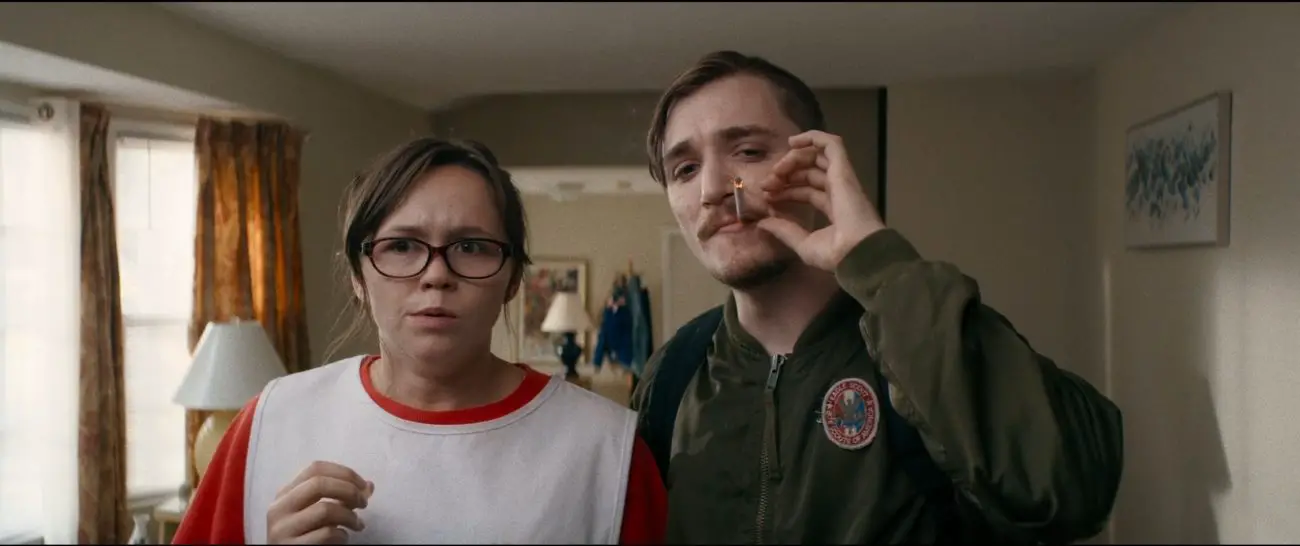I confess it took me more than a few minutes to warm to writer-director-editor Adam Carter Rehmeier’s Dinner in America, a Sundance hit coming this week to theaters. Its tone is immediately apparent as its protagonist, Simon (Kyle Gallner), a punk misfit with bad manners and worse hair, spends the first act blustering and spewing vitriol against pretty much anything and anyone he sees. He’s a bundle of unfocused rage and not much else.
The film opens with Simon suffering the first of several “dinners in America”—this one during a drug study in a college lab, one of more than a few places he doesn’t belong. Kicked out and on the run, he’s invited to another dinner, this time at the suburban home of one of his test-mates, where her horny mom (Lea Thompson, still making horny funny four decades after Back to the Future) makes a pass and her patriarchal dad and brother challenge his masculinity.
Simon’s response? Burn it down. At least, that is, burn their front-lawn shrubbery down, after trashing their furniture and breaking their plate-glass window. That act of punk pride gets the police’s attention, and soon Simon is a rebel without a cause or a home. It’s the second “dinner in America” that goes belly-up; there will later be a third and a fourth, none of them too successful.
The film’s title comes also from Simon’s artistry, something we learn about only in the second act. Turns out he’s the ski-masked lead singer of the underground punk-rock band PSYOPS. And one with a smitten anonymous fan who’s been sending him mash notes with pantie pics snapped with her Polaroid. What are the chances that, on the lam, Simon’s going to find himself at that fan’s house?
Frankly, those chances are infinitesimal, but Dinner in America is dependent on that coincidence. Once a desperate Simon, on the run from the local police, runs into eccentric pet-store employee Patty (Emily Skeggs), the film takes flight. Patty’s dull demeanor and pet-store smock belie an intelligence and empathy her relentless bullies—and there are many—don’t see. The two share a dinner at Patty’s home, where Simon tries a different technique, lying and fawning his way through the affair, and spend some time alone together.
Simon’s perpetual rudeness softens just a bit when he learns Patty is PSYOPS’ biggest fan—and yes, the one who’s been sending him those Polaroids. She’s not just a dupe or a mark, but someone who is genuinely moved by the music Simon and his band make. Confronted with the realization, Simon is so gobsmacked he hardly knows how to react. For a while, he keeps his revelation to himself, and opens up to learning a bit more about the nerdy chick he’s now learned is his band’s biggest fan.

And here’s where Simon—and Dinner in America—opens up its heart. Its first act brings the cringe, with Simon the target of unlikely seductions twice in the first ten minutes. But those moments of cringe don’t yield many laughs, just painful winces. The tone, set by the film’s musical score (by John Swihart) and cinematography (by Jean-Philippe Bernier) aims less for realism than for an outrageous, outsize punk-inspired skewering of mid-American mores based on hyperbole and stereotype. It feels for a time like “dinner in America” won’t be served.
Fortunately, Patty’s presence changes that. Special credit goes to Emily Skeggs, who’s given a role that could descend into stereotype. Skeggs imbues Patty with a patient, skeptical intelligence that matches her passion for punk music. A scene where Simon invites Patty to make music with him is quietly transcendent, rewarding viewers for the patience they’ll need to weather the first act’s cringe comedy.
Dinner in America, for all its post-punk ethos of stick-it-to-the-man, has more in common with a long connection of lovers-on-the-lam films, those narratives of young lovers taking to the road to escape the rote humdrum of their otherwise unfulfilling lives. Whatever the cause of their flight, their plight creates empathy, whether the couple are master criminals, petty thieves, random acquaintances, or wrongfully accused. It’s a love that develops under duress and brings together two disparate characters in an us-against-the-world journey, even if the ultimate destination is rarely known or successfully reached.

And the subgenre’s been around a long while, going back at least as far as the crime dramas of the 1930s, through the French New Wave and New Hollywood eras, with some wild swerves in tone and style more recently. Just think of films like You Only Live Once (1937), Ossessione (1943), Gun Crazy (1950), Breathless (1960), Pierrot le Fou (1965), Bonnie and Clyde (1967), Badlands (1973), Thieves Like Us (1974), Something Wild (1986), Wild at Heart (1990), My Own Private Idaho (1991), True Romance (1993), Natural Born Killers (1994), even, more recently, with a more whimsical tone, Wes Anderson’s Moonrise Kingdom (2014) or the recent Queen and Slim (2019).
Even if they often romanticize crime, most of those films take their characters’ crimes seriously. Dinner in America‘s protagonists may remind viewers more of the Dawn Weiners and Napoleon Dynamites of the world than of Bonnie Parker and Clyde Barrow: Simon and Patty are no real danger to anyone. They are two misfits for sure, who find each other via contrivance and coincidence, but together they share something profound. Their love may be fleeting, but it’s no less meaningful, and Dinner in America shines brightest when the two share their punk passions.




